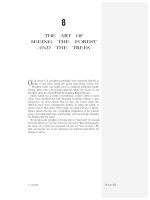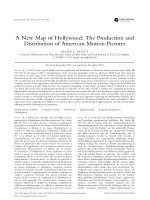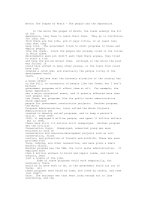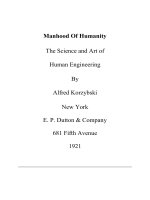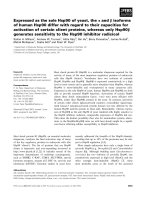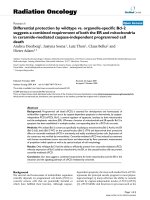Keith walker, nicholas fisher john wilmot, earl of rochester the poems and lucinas rape 2010
Bạn đang xem bản rút gọn của tài liệu. Xem và tải ngay bản đầy đủ của tài liệu tại đây (1.55 MB, 296 trang )
JOHN WILMOT, EARL OF ROCHESTER
THE POEMS AND LUCINA’S RAPE
Books of related interest
John Milton Complete Shorter Poems edited by Stella P. Revard
John Milton, Paradise Lost edited by Barbara K. Lewalski
JOHN WILMOT,
EARL OF ROCHESTER
THE POEMS
AND
LUCINA’S RAPE
EDITED BY
KEITH WALKER and NICHOLAS FISHER
A John Wiley & Sons, Ltd., Publication
This edition first published 2010
© 2010 Keith Walker and Nicholas Fisher
Blackwell Publishing was acquired by John Wiley & Sons in February 2007. Blackwell’s publishing
program has been merged with Wiley’s global Scientific, Technical, and Medical business to form
Wiley-Blackwell.
Registered Office
John Wiley & Sons Ltd, The Atrium, Southern Gate, Chichester, West Sussex, PO19 8SQ, United
Kingdom
Editorial Offices
350 Main Street, Malden, MA 02148-5020, USA
9600 Garsington Road, Oxford, OX4 2DQ, UK
The Atrium, Southern Gate, Chichester, West Sussex, PO19 8SQ, UK
For details of our global editorial offices, for customer services, and for information about how to apply
for permission to reuse the copyright material in this book please see our website at
www.wiley.com/wiley-blackwell.
The right of Keith Walker and Nicholas Fisher to be identified as the authors of this work has been
asserted in accordance with the UK Copyright, Designs and Patents Act 1988.
All rights reserved. No part of this publication may be reproduced, stored in a retrieval system, or
transmitted, in any form or by any means, electronic, mechanical, photocopying, recording or
otherwise, except as permitted by the UK Copyright, Designs and Patents Act 1988, without the prior
permission of the publisher.
Wiley also publishes its books in a variety of electronic formats. Some content that appears in print
may not be available in electronic books.
Designations used by companies to distinguish their products are often claimed as trademarks.
All brand names and product names used in this book are trade names, service marks, trademarks
or registered trademarks of their respective owners. The publisher is not associated with any product
or vendor mentioned in this book. This publication is designed to provide accurate and authoritative
information in regard to the subject matter covered. It is sold on the understanding that the publisher
is not engaged in rendering professional services. If professional advice or other expert assistance is
required, the services of a competent professional should be sought.
Library of Congress Cataloging-in-Publication Data
Rochester, John Wilmot, Earl of, 1647–1680.
John Wilmot, Earl of Rochester : the poems, and Lucina’s rape / edited by Keith Walker and Nicholas
Fisher.
p. cm.
Includes bibliographical references and index.
ISBN 978-1-4051-8779-4 (alk. paper)
I. Walker, Keith, 1936–2004 II. Fisher, Nicholas III. Title.
PR3669.R2A6 2010
821'.4–dc22
2009032171
Hbk: 9781405187794
A catalogue record for this book is available from the British Library.
Set in 11/13.5pt Dante by Graphicraft Limited, Hong Kong
Printed in Malaysia
1
2010
IN MEMORY OF
KEITH WALKER & HAROLD LOVE
(1936–2004)
(1937–2007)
Figure 1.
Engraved portrait of Rochester, 1681 (collection of Howard Erskine-Hill)
Contents
List of Illustrations
Note on This Edition
Acknowledgments
Chronology
Introduction
Further Reading
Abbreviations
viii
ix
x
xii
xvii
xxviii
xxxii
POEMS
Juvenilia
Love Poems
Translations
Prologues and Epilogues
Satires and Lampoons
Poems to Mulgrave and Scroope
Epigrams, Impromptus, Jeux d’esprit, etc.
Poems Less Securely Attributed to Rochester
1
5
56
61
68
111
131
138
LUCINA’S RAPE OR THE TRAGEDY OF VALLENTINIAN
161
Index of Proper Names
253
Index of Titles and First Lines
257
List of Illustrations
1. Engraved portrait of Rochester, 1681 (collection of Howard Erskine-Hill)
vi
2. Title-page of Poems on Several Occasions By the Right Honourable,
The E. of R— (Antwerp [London], 1680) ( Pepys Library, Magdalene
College, Cambridge)
xxxiv
3. ‘How perfect Cloris, and how free’, Nottingham University MS
Portland Pw V 31
22
4. Title-page A Satyr against Mankind [London, 1679] ( private collection)
89
5. Upon Nothing, National Archives, Kew, Box C 104/110 Part 1
105
6. Lucina’s Rape Or The Tragedy of Vallentinian, British Library Add.
MS 28692 (title-page)
161
7. Lucina’s Rape Or The Tragedy of Vallentinian, British Library Add.
MS 28692 (correction to I.i.166)
173
8. Lucina’s Rape Or The Tragedy of Vallentinian, British Library Add.
MS 28692 (correction to V.iv.37)
238
Note on This Edition
Keith Walker died in 2004. This is a revised and updated version of his acclaimed
1984 edition of Rochester’s poems, to which has been added the play Lucina’s Rape
Or The Tragedy of Vallentinian (first published as Valentinian: A Tragedy ( London,
1685)). Where possible, privately-produced texts from sources close to Rochester –
in his holograph or from within his wider family or from a highly placed Court official
– have been selected. Until Harold Love’s comprehensive edition for Oxford
University Press in 1999, Walker’s had been the only full, critical, old-spelling edition of Rochester’s verse and the preferred edition for many Rochester scholars. Love’s
detailed records of manuscript variations have superseded the comparatively limited
textual comparisons Walker included, and these have therefore now been omitted,
not least in order to prevent this revision becoming too unwieldy. It remains true to
the spirit of Walker’s edition, however, not least in the arrangement of the poems
by genre (and where possible chronologically), in the notes and above all in following Walker’s original principle of making Rochester available to students and scholars
‘in versions that were read in his lifetime’.
Acknowledgments
My chief debts are, firstly, to Ken Robinson, who introduced me to the Earl of Rochester
while I was an undergraduate at the University of Newcastle upon Tyne, and then
supervised my master’s dissertation on satiric and verse epistles in the Restoration
Period; and, secondly, to Paul Hammond at the University of Leeds who was the
supervisor of my doctoral dissertation on the early publishing history of Rochester’s
work, and has generously continued to allow me to draw on his detailed knowledge
of Restoration literature. I cannot adequately express my debt to them both, and
particularly to Paul Hammond, for their stimulation, patience and advice over a lengthy
period. I am also most grateful for the individual kindnesses and encouragement I
have received from Philip Aherne, Peter Beal, John Carey, Larry Carver, Warren
Chernaik, Robert Hume, David Gareth Jones, Thomas MacFaul, Brian Oatley,
James Grantham Turner and Henry Woudhuysen. Philippa Martin, Curator of the
Government Art Collection, provided invaluable advice and help, and Howard
Erskine-Hill generously allowed me to include an illustration of Rochester from his
extensive collection of prints from the long eighteenth century. This edition has
also profited greatly from the enthusiasm and expertise of the publishing team at
Blackwell – Emma Bennett, Caroline Clamp, Isobel Bainton and Sarah Pearsall – and
I must also record the tolerance of my wife Pam, and children Francis, Rachel and
Harriet, which has been nothing short of heroic.
For permission to reproduce manuscript materials in their possession, I am grateful to the following: the Marquess of Bath, Longleat House, Warminster, Wiltshire
(Thynne Papers, Vol. XXVII); the British Library, London; the Bodleian Library,
University of Oxford; the National Archives, Kew, Richmond, Surrey; Leeds
University Library (the Brotherton Collection); University of Nottingham Library (the
Portland Collection); the National Art Library, Victoria and Albert Museum,
London; the Beinecke Rare Book and Manuscript Library, Yale University; the
Houghton Library, Harvard University; and the Kungliga Biblioteket, Stockholm.
The title page of the 1680 edition of Rochester’s poems is reproduced by kind
Acknowledgments
xi
permission of Magdalene College, University of Cambridge. To the librarians and
staff of all these institutions I express my warmest thanks for their assistance.
The work for this edition was undertaken while I was a Visiting Research Fellow
at the Institute of English Studies, School of Advanced Study, University of London,
and I thank Warwick Gould for his generosity in extending my fellowship to allow
me to undertake the necessary study. Latterly a Visiting Research Fellowship at Merton
College, Oxford, allowed the project to be completed and I am most grateful to the
Warden, Chaplain and Fellows for the generosity of their welcome and hospitality.
My obligation to Keith Walker will be apparent on almost every page (and
coincidentally he supplied me with his transcript of the Harbin MS when I was
completing my doctorate). But as Keith did a quarter of a century ago, so I end by
acknowledging my debt to Harold Love. It was he who suggested that I should undertake this revision, and he then took an active interest in my progress; one of his last
communications was to bring his discovery of another text of ‘My dear Mistress’ to
my attention. This volume is dedicated to the memory of these two outstanding
Rochester scholars.
Nicholas Fisher
Chronology
Historic and Literary Events
Rochester’s Life
1 April: born at Ditchley House,
Oxfordshire, son of Henry,
Lord Wilmot and Anne, widow
of Sir Henry Lee
1647
1649
1651
13 December: father created Earl of
Rochester
1652
Rochester in Paris with mother
1653
Still in Paris
19 February: succeeds to earldom on
death of father at Ghent
1654
1658
1659
30 January: execution of Charles I;
future Charles II in exile at The Hague
19 May: England declared a
Commonwealth or Free State
2 August: Charles II invades England
3 September: royalist army defeated at
Battle of Worcester and Charles
escapes to France with Lord Wilmot
Thomas Hobbes, Leviathan
Christopher Bowman opens first
coffee-house in London in St Michael’s
Alley, Cornhill
10 July: start of First Dutch War
(1652–54)
16 December: Cromwell becomes
Lord Protector
3 September: Cromwell dies; son
Richard succeeds as Lord Protector
25 May: Richard Cromwell resigns,
Rump Parliament re-establishes
Commonwealth
13 October: army-controlled Committee
of Safety replaces Rump Parliament
26 December: Rump Parliament
re-instated
Chronology
Rochester’s Life
xiii
Historic and Literary Events
18 January: matriculates at Wadham
College, Oxford
c. May: ‘Vertues triumphant Shrine’
c. December: ‘Impia blasphemi’
1660
2 January: Monck’s forces enter
England
3 February: Monck enters London
4 April: Charles’s Declaration of Breda
issued
8 May: Charles proclaimed King in
London
29 May: Charles enters London
21 August: patents granted for
re-opening of theatres
c. January: ‘Respite great Queen’
February: awarded pension of £500 p.a.
9 September: receives degree of MA
from Chancellor, Earl of Clarendon
21 November: embarks on Grand Tour
with Sir Andrew Balfour
1661
20 December: Corporation Act
1662
19 May: Act of Uniformity with revised
Book of Common Prayer attached receives
royal assent
10 June: Licensing Act takes effect
21 May: Charles II marries Catholic
Catherine of Braganza
1663
Butler, Hudibras Part I
7 May: Theatre Royal, Drury Lane
opens
1 October: in Venice
26 October: signs Visitors’ Book at
University of Padua
Visits Charles II’s sister Henrietta,
Duchess of Orleans
25 December: delivers letter from
Henrietta to Charles II at Whitehall
1664
Butler, Hudibras Part II
26 May: attempts to abduct heiress
Elizabeth Malet; imprisoned in Tower
19 June: freed from Tower
6 July: joins Fleet
2 August: under fire in Bergen harbour
9 September: still with Fleet
16 September: back at Court
31 October: gift of £750 from King
1665
4 March: Second Dutch War (1665–67)
begins
3 June: Dutch fleet defeated at Battle
of Lowestoft
5 June: theatres in London closed by
Plague
September: Great Plague recedes
October: Five Mile Act
xiv
Chronology
Rochester’s Life
21 March: appointed Gentleman of the
Bedchamber to Charles II with pension
of £1,000 p.a. and lodgings in Whitehall
June: commissioned in Prince Rupert’s
Troop of Horse
June–July: naval service under Sir
Edward Spragge, displaying conspicuous
bravery
29 January: marries Elizabeth Malet
14 March: assumes post of Gentleman of
the Bedchamber
29 July: summoned to Parliament by
royal writ
2 October: pension of £1,000 authorised
10 October: takes seat in House of Lords
28 February: appointed Gamekeeper for
Oxfordshire
16 February: strikes Thomas Killigrew in
King’s presence; pardoned
12 March: sent to Paris by Charles II
with letter for his sister
19 April: robbed of valuables in Paris
21 June: set upon at the Paris opera
July: returns to England
30 April: daughter Anne baptised at
Adderbury
22 November: forced by illness to
decline duel with Mulgrave
Historic and Literary Events
1666
25 July: Dutch defeated in Battle of
North Foreland
2–5 September: Great Fire of London
16 November: first issue of London
Gazette
Nicolas Boileau-Despréaux, Satires
1667
13 June: Dutch destroy English fleet on
Medway, capture flagship Royal Charles
29 November: Chancellor Hyde flees
to France; replaced by ‘Cabal’ ministry
under Arlington
Dryden, Annus Mirabilis
Milton, Paradise Lost
Dryden appointed Poet Laureate
Dryden, An Essay of Dramatick Poesie
21 August: Death of Queen Mother,
Henrietta Maria
1668
1669
1670
2 January: son Charles baptised
Autumn: ‘All things submit themselves’,
‘Cælia, that faithful Servant’
1671
22 May: Charles signs secret Treaty of
Dover
October: Arrival of Louise de
Kerouaille (future mistress to King;
created Duchess of Portsmouth)
Dryden, Conquest of Granada, Pt. 1
Thomas D’Urfey, Wit and Mirth
9 November: Dorset Garden Theatre
opens
Milton, Paradise Regain’d and Samson
Agonistes
Dryden, Conquest of Granada, Pt. II
Buckingham, The Rehearsal
Wycherley, Love in a Wood
31 March: Death of Duke of York’s
wife Anne Hyde
Chronology
Rochester’s Life
xv
Historic and Literary Events
31 October: appointed Deputy
Lieutenant of Somerset
‘What vaine unnecessary things’
1672
‘Att five this Morn’
‘As some brave Admiral’
21 March: duel with Viscount Dunbar
prevented
Spring: dedicatee of Dryden’s Marriage-ala-Mode
‘The Gods, by right of Nature’
‘Wit has of late’
‘In the Isle of Brittain’
1673
January: leaves Court after delivering
‘In the Isle of Brittain’ in error to King
27 February: appointed Ranger of
Woodstock Park
‘What Timon, does old Age, begin’
2 May: appointed Keeper of
Woodstock Park
‘Strephon, there sighs not’
Satire against Man
13 July: daughter Elizabeth baptised
1674
9 February: peace concluded with
Dutch
26 March: opening of new Drury Lane
Theatre
September: collapse of ‘Cabal’ ministry
4 January: Charles approves building of
small building at Whitehall Palace for
Rochester
24 January: appointed Master, Surveyor
and Keeper of King’s hawks
Late Spring: dedicatee of Lee’s Nero
May: occupies High Lodge, Woodstock
25 June: smashes King’s chronometer in
Privy Garden
‘Well Sir ’tis granted’
1675
Spring: Crowne’s Calisto produced at
Court
17 August: Charles signs agreement
with Louis XIV to dissolve Parliament
if supplies not provided
6 January: daughter Malet baptised
February: ill, reported dead
March: Satire against Man circulating
17 June: brawl with Watch at Epsom
resulting in death of Billy Downs
Summer: Alexander Bendo disguise
1676
16 February: Charles concludes second
secret treaty with Louis XIV, receiving
£100,000 p.a.
Etherege, The Man of Mode
Wycherley, The Plain Dealer
Shadwell, The Virtuoso
25 January: Theatre Royal burns
down
15 March: Charles issues Declaration
of Indulgence
17 March: Third Dutch War begins
(1672–74)
28 May: indecisive naval battle off
Southwold
29 March: imposition of the Test Act
20 September: Duke of York marries
by proxy Catholic Mary of Modena
Autumn: a ‘country party’, opposed to
anti-Tolerationist policies of King’s
chief minister, Danby, starts during
parliamentary session to form around
Halifax and Shaftesbury; Buckingham
joins early 1674, and within a decade
group formalised as ‘Whig’ party
xvi
Chronology
Rochester’s Life
Historic and Literary Events
Spring: begins liaison with Elizabeth Barry
13 April: petitions King for estates in
Ireland
‘Some few from Wit’
4 June: Cook stabbed at tavern in Mall
where Rochester dining
August: entertains Buckingham in
lodgings at Whitehall
October: receives visit from Buckingham
at Woodstock
November: elected Alderman at
Taunton, Somerset
December: daughter Elizabeth Clerke
born to Elizabeth Barry
Early in year: very ill
Upon Nothing
1677
Dryden, All for Love
February: Shaftesbury, Buckingham
and others imprisoned by House of
Lords
4 November: William of Orange
marries Princess Mary
1678
‘Dear Friend. I hear this Town’
October: begins weekly conversations in
London with Burnet (until April)
1679
March: accepts challenge from Edward
Seymour, but duel averted
End April: leaves London for last time;
travels to Somerset; health collapses
End May: brought by coach to Woodstock
June: repents his life, and is reconciled
with Church of England; visited by many
clergymen
20–24 July: visited by Burnet
26 July: dies at High Lodge, Woodstock
Autumn: unauthorised publication of
Poems on Several Occasions
November: publication of Burnet’s Some
Passages of the Life and Death of . . .
Rochester
1680
Butler, Hudibras Part III
17 May: secret treaty between Charles
and Louis XIV promising neutrality in
return for subsidy
13 August: first allegations of Popish
Plot
20 November: Additional Test Act passed
26 May: Parliament prorogued and
dissolved (12 July) to prevent passage
of Exclusion Bill (reconvenes
21 October 1680)
Summer: Jane Roberts, former mistress
of King, dies, attended by Gilbert Burnet
May/June: Parliament fails to renew
Licensing Act
4 December: death of Thomas Hobbes
Burnet, History of the Reformation of the
Church of England, vol. 1
April: Penny post system established in
London by William Dockwra
Introduction
The Man
John Wilmot, second Earl of Rochester, was born on All Fools’ Day, 1647, at
Ditchley in Oxfordshire on the estate that had belonged to his mother’s first husband, Sir Henry Lee. Rochester’s father, Lord Wilmot, was a royalist general; witty,
restless and hard-drinking, he was with the exiled court in Paris, and hardly saw his
son. In consequence Rochester was brought up by his mother, who was tough-minded
and a not uncommon example of well-born female piety. Although his exposure to
the Bible and Prayer Book would continue through the daily routine of biblical study
and prayers at his school, it was probably she who so impressed those texts on his
memory that he would remember their cadences on his deathbed.
Rochester spent part of his childhood in Paris, but most of it in Oxfordshire. He
was tutored by his mother’s chaplain, attended Burford Grammar School, and went
up to Wadham College at the age of 12. He was at Oxford when King Charles came
back to England, and he grew debauched there with the active encouragement of Robert
Whitehall, a fellow of Merton college. (His more formal education would in any case
have ended when he left Burford Grammar School: post-Restoration Oxford was not
a place where young gentlemen were expected to study.) He took his degree of Master
of Arts in 1661, and for the next three years he travelled in France and Italy with a
Scottish physician as his tutor. He arrived back at the court which was to be the centre of his life on Christmas Day 1664, with a letter for Charles from his sister in Paris.
Described by his biographer Gilbert Burnet as ‘tall and well made, if not a little
too slender’,1 Rochester quickly gained a reputation for easy grace and wit. He was
the youngest member of his set apart from Sir Carr Scroope and John Sheffield, Earl
of Mulgrave. He was later to quarrel with both men, facts recorded substantially in
his poetry.
1
Some Passages of the Life and Death Of the . . . Earl of Rochester (London, 1680), pp. 6 –7.
xviii
Introduction
What is known of Rochester’s life as a courtier is mostly in this early period, before
myth takes over the record. A suitor for an heiress, Elizabeth Malet, Rochester kidnapped her prematurely, and was punished by Charles with imprisonment in the Tower,
from which he was soon freed, to make good his disgrace by fighting bravely in a
sea battle against the Dutch (and subsequently marrying Elizabeth with the King’s
blessing). His earliest extant letter is a full account of his experiences, which make
the ironic reference to ‘Dutch prowess’ in Upon Nothing ( l. 46) puzzling.2
Certain patterns of life can be discerned: recurrent bad behaviour, for which Rochester
was first in disgrace, then quickly forgiven by the indulgent Charles; drunkenness,
quarrels, duels, and (the details are more doubtful here) love affairs. He had four
legitimate children and a bastard daughter by the actress Elizabeth Barry. When in
disgrace, Rochester would disappear to France, or go into hiding and disguise. Gilbert
Burnet records:
He took pleasure to disguise himself, as a Porter, or as a Beggar; sometimes to follow some mean Amours, which, for the variety of them, he affected; At other
times, meerly for diversion, he would go about in odd shapes, in which he acted
his part so naturally, that even those who were on the secret, and saw him in these
shapes, could perceive nothing by which he might be discovered. (Some Passages,
pp. 27–8)
The ability to assume another’s role is a striking feature of Rochester’s poetry, as of
his life.3
Rochester was deeply involved with the Restoration stage, and this involvement
is probably the most fully documented series of facts about his life. He seems to
have acted as patron to most of the playwrights – Dryden, Shadwell, Crowne, Lee,
Otway, Settle and Fane – and the majority of these have left us testimonies of
their relations with him, unfortunately usually only in the form of a dedication.
Rochester’s only full-length play, Lucina’s Rape Or The Tragedy of Vallentinian, adapted
and improved Fletcher’s The Tragedie of Valentinian, but he also contributed a scene
to a play by Robert Howard, began a prose comedy, and contributed the prologue
or epilogue to four plays.4 Theatrical motives and imagery dominate much of his
verse.
In the later 1670s there is evidence of greater seriousness and greater involvement
in affairs of state. During the middle of the decade, four events of importance are
2 It might, however, be a topical reference to the defeat of William of Orange by the French at Mont Cassell
on 11 April 1677, and the subsequent Dutch focus on seeking peace, which was not achieved until the
Treaty of Nijmegen was signed with the French on 10 August 1678.
3 Role-playing and disguise in Rochester is the theme of Anne Righter’s British Academy lecture
(Proceedings of the British Academy, 53, 1967, 1968).
4 The case for Rochester’s authorship of the obscene farce Sodom is unconvincing (see Harold Love, ‘But
Did Rochester Really Write Sodom?’, PBSA, 87 (1993), 319–36).
Introduction
xix
recorded: Rochester’s accidental handing of his satire ‘In the Isle of Brittain’ to the
King during the festivities at Court at Christmas 1673; his destruction of the sundial
in the Privy Garden at Whitehall on 25 June 1675; his part in the affray at Epsom
on 17 June 1676 that led to the death of a Mr Downs (see the description given in
the notes to ‘To the Post Boy’); and later that summer his setting up in disguise as
the medical practitioner ‘Alexander Bendo’ on Tower Hill, London. Between
February and May, 1677, he regularly attended the House of Lords, and in the preface to the printed edition of Rochester’s play (Valentinian (London, 1685)), Robert
Wolseley confirms his interest in politics during his last years. His self-styled ‘death
bed repentance’5 followed from a series of regular conversations he had between October
1679 and April 1680 with a former chaplain to the King, Gilbert Burnet, and is recorded
in Some Passages. This conversion, whether real or fantasy, figured largely in his
reputation but has little to do with the quality of his poetry. Rochester died on
26 July 1680.
***
One Man reads Milton, forty Rochester,
This lost his Taste, they say, when h’lost his Sight;
Milton has Thought, but Rochester had Wit.
The Case is plain, the Temper of the Time,
One wrote the Lewd, and t’other the Sublime.
(‘Reformation of Manners’, Poems on Affairs of State (London, 1703), p. 371)
Who read Rochester? In his An Allusion to Horace Rochester himself suggested a fit
audience:
’tis enough for me
If Sydley, Shadwell, Shepheard, Wicherley,
Godolphin, Butler, Buckhurst, Buckinghame
5
And some few more, whome I omitt to name
6
Approve my sence, I count their Censure Fame. 7
( ll. 120–4)
The negligent ‘whome I omitt to name’ has a direct origin in the Latin of Horace
that Rochester is imitating, but he would have agreed that to worry about the effect
one was making was not quite proper. Apart from his fellow ‘wits’ (some of whom,
to be sure, were writers) Rochester mentions two professional writers, Shadwell and
Butler (if the author of Hudibras is meant). We may be sure that his fellow writers
read him. Marvell considered him ‘the best English satyrist’ and thought that he ‘had
5
A Letter to Dr. Burnet from the Earl of Rochester [London, 1680], sig. A1v.
xx
Introduction
the right veine’; in Mr Smirke; or the divine in mode (1676), Marvell quotes from the
as yet unpublished A Satyre against Reason and Mankind. Dryden, Aphra Behn,
Thomas Otway, John Oldham, Edmund Waller, Samuel Pepys, and John Evelyn all
read him.6 The first record of close reading by a contemporary is the Court sermon
preached on 24 February 1675 against Rochester’s satire (among other things) by Edward
Stillingfleet (1635–99), who clearly found the tenor of the poem subversive.
Stillingfleet, a future Dean of St Paul’s and Bishop of Worcester, was one of the
King’s chaplains, so it is unsurprising that he should have seen the poem before it
was printed. The poem attracted four verse replies: An Answer to the Satyr against
Man, by the Oxford orientalist Edward Pococke (1648 –1727) appeared as a broadside in July 1679; A Satyr, In Answer to the Satyr against Man, by a member of
Rochester’s Oxford college, Thomas Lessey, was first published in the miscellany collection Poetical Recreations in 1688; the anonymous Corinna, or, Humane Frailty. A Poem.
With an Answer to the E. of R—-’s Satyr against Man in 1699; and the anonymous
manuscript poem An answer to a Sat[?yr against R]eason & Mankind (Cambridge
University Add. MS 42).7
Very soon after Rochester’s death a pirated edition of his poems appeared which
quickly went into 11 or more editions. It was published ‘meerly for lucre sake’, as
the antiquary Anthony à Wood put it, so presumably there were buyers. The complex proliferation of editions (there are four series of Rochester’s poems) continued
throughout the eighteenth century.
Text
The complexity of the situation of Rochester’s texts is paralleled only by that of Donne’s,
for in each case, only a few poems were published in the poet’s lifetime, and a
single body of texts on which to base an edition is simply unavailable to an editor.
The first printed edition of Donne, in 1633, was derived from non-authoritative
manuscript copies, and his editor, as with Rochester, is faced with the task of having to evaluate many manuscript copies. Only nine poems by Rochester, some showing signs of revision, have survived in his own hand, and, so far as is known, he
authorised the publication of just three works written when he was 13, together with,
implicitly, the prologues or epilogues he contributed to four staged plays. The five
6
For a useful summary, see Rochester: The Critical Heritage, ed. David Farley-Hills (London, 1972),
pp. 5–12. This compilation usefully charts Rochester’s reputation as a poet during his lifetime and up to
the early part of the twentieth century. Current appreciation of Rochester as a writer of significant ability is traceable to the publication of the ground-breaking editions of Pinto (1953) and Vieth (1968).
7 For transcriptions of the Cambridge MS, together with the fuller version of Lessey’s poem that appears
in BL Harleian MS 6207, see Nicholas Fisher, ‘The Contemporary Reception of Rochester’s A Satyr Against
Mankind’, Review of English Studies, 57 (2006), 185–220.
Introduction
xxi
most important collections are in the two printed texts Poems on Several Occasions
By the Right Honourable, the E. of R— ([London], 1680) and Jacob Tonson’s Poems, &c.
on Several Occasions: with Valentinian, A Tragedy (London, 1691), and in three
manuscripts: Yale University MSS Osborn b 105 and b 334 (the latter known as the
‘Hartwell’ MS) and Thynne Papers, vol. XXVII at Longleat House, Wiltshire (the
‘Harbin’ MS).
1680 contains 61 poems, only 33 of which are now thought to be by Rochester.
The collection is badly printed, bears no publisher’s name, and has the false imprint
‘Printed at ANTWERP’. Eleven closely similar but separate editions, spanning some
10 years, have been identified.8 1691 was published, and probably edited, by Jacob
Tonson, with a preface by Thomas Rymer; it contains 39 poems, 37 of which are
now considered to be by Rochester, and attributes eight to him for the first time.
For long, 1691 was thought to be the best early edition of Rochester’s work, but whereas
1680 has all the marks of an unauthorised edition, 1691 has all the deficiencies of an
authorised one: it omits violently personal poems like On Poet Ninny, Epigram upon
my Lord All-pride, On the supposed Author of a late Poem in defence of Satyr, A very Heroicall
Epistle In answer to Ephelia; it also omits temperately personal poems like An Allusion
to Horace (out of deference to Dryden, whose publisher Tonson was?), and obscene
poems like ‘I Fuck no more than others doe’, On Mrs. W— llis, Mistress Knights Advice
to the Dutchess of Cleavland, in Distress For A Prick, and A Ramble in Saint James’s Parke.
It is an avowedly castrated text,9 omitting stanzas from The Disabled Debauchee, ‘How
happy Chloris, were they free’, Love to a Woman, and ‘Fair Cloris in a Piggsty lay’.
Worse, from the point of view of an editor who wishes to base a text on 1691, its
versions of some 19 of the poems it has in common with 1680 are derived wholly
or in part from the earlier collection.
Yale MS Osborn b 105 is closely related to the ancestor of 1680, and is an anthology of Restoration poetry, with attributions that are in general reliable, and on the
whole good texts for 30 of the poems. Unfortunately there are seven gaps of 45 leaves
which have been cut away ( pp. 35–44, 63–6, 77–86, 115–32, 153–8, 161–84, 195–212).
David M. Vieth has painstakingly investigated the probable contents of these missing leaves,10 and concludes that the whole or part of eight or possibly more poems
probably by Rochester are missing from the Osborn manuscript. Among these are,
8
See Rochester’s Poems on Several Occasions, ed. James Thorpe (Princeton, NJ, 1950), pp. xi–xxii; Nicholas
Fisher and Ken Robinson, ‘The Postulated Mixed “1680” Edition of Rochester’s Poetry’, PBSA, 75 (1981),
313–15.
9 ‘For this matter the Publisher assures us, he has been diligent out of Measure, and has taken exceeding
Care that every Block of Offence shou’d be removed.
So that this Book is a Collection of such Pieces only, as may be received in a vertuous Court, and not
unbecome the Cabinet of the Severest Matron’. (1691, sig. A6v (italics reversed))
10 His conclusions are set out in Attribution in Restoration Poetry: A Study of Rochester’s Poems of 1680 (New
Haven, 1963), pp. 93–100.
xxii
Introduction
beyond doubt, such substantial poems as A Ramble in Saint James’s Park, and The Imperfect
Enjoyment.
The Hartwell and Harbin MSS are two ‘vitally important’ documents that draw
on a source that was available to Tonson for 1691, and (on the basis that none of the
indecent poems are included) which was possibly prepared for, or even by, one or
other female members of Rochester’s extended family, such as his niece Anne
Wharton.11 They contain, respectively, texts for 26 and 24 of the poems, and an additional significance of the Hartwell MS is that not only is it the only major
manuscript that purports to consist of Rochester’s work, but it also contains one of
just three surviving copies of his play Lucina’s Rape.
A further 31 poems––half of which are jeux d’esprit of a few lines, but which also
include longer works such as ‘In the Isle of Brittain’, Seigneur Dildoe and the
unfinished ‘What vaine unnecessary things are men’––are not to be found in any of
the collections cited above but are scattered in individual manuscript miscellanies
and printed collections from the late seventeenth and early eighteenth centuries. The
most important manuscripts in this group are Nottingham University MS Portland
Pw V 31,12 which include the poems in Rochester’s hand, and two manuscripts
which contain corrections in the hand of Rochester’s mother: BL Add. MS 28692
(which contains Lucina’s Rape) and a copy of Upon Nothing in National Archives,
Box C 104/110.
Lacking a single basic reliable text, the editor of Rochester has to make his or her
own rules. It is hardly possible to present a printed transcription of a manuscript which
represents that manuscript faithfully in every respect. Choices have continually to
be made. If superscript letters are printed above the line, where should those letters
that seem only half-way above it be printed? Again, some scribes will write S and C
for initial s and c almost (but never completely) throughout a poem, their Ss and Cs
varying in size from full capitals to small letters. Yet again, in an attempted diplomatic transcription a few poems would come out, in an extreme case, with lines like
this:
I’ th Isle of Britaine Long since famous growne
ffor Breedingye. Best C.tts. In Xtendome
Their Reigns (& oh Long May hee Reigne & there
The easiest king & Best Bred Man alive
him no Ambition Mooves, To Gett Renowne
Like The french foole To wand.r up & Downe
( Bod. MS Rawl. D. 924)
11
See Harold Love, ed., The Works of John Wilmot Earl of Rochester (Oxford, 1999), p. xxxvii; ‘Rochester:
A Tale of Two Manuscripts’, Yale University Library Gazette, 72 (1997), 41–53, p. 49.
12 A full description is given in Vieth, Attribution in Restoration Poetry, pp. 204–30.
Introduction
xxiii
This would be intolerable. And so, while a few contractions have been retained which
are still in use today, such as ‘2d’ for second, instances of scribal contractions, ampersands, and the like have been silently expanded; ‘∫’ ( long s) has been silently ordered
to ‘s’, ‘β’ to ‘ss’, and ‘VV’ to ‘W’, and in accordance with modern usage, the letters ‘v’
and ‘u’, and ‘i’ and ‘j’ have been interchanged. All dates are given in Old Style, except
that the year is presumed to begin on 1 January, and not 25 March. These apart, all
departures from the copy-text have been recorded in the textual notes; for reasons
of space, the reader is referred to Love’s edition for the source of the emendations.
There can be no certainty, except in a few cases, that Rochester’s own spelling or
punctuation has been reproduced. The poems in Rochester’s holograph, and a few
of the copy-texts, have almost no punctuation; here these have been punctuated lightly,
relying on the reader’s prompt appreciation that the convention was for a line to
be end-stopped, regardless of the absence of punctuation, unless the sense made it
inappropriate. Capitals and italics may also cause the modern reader difficulty, for
although the seventeenth-century convention was for key words to be emphasised
in this way, scribes and printers were often erratic both in their observance of what
was on the sheet before them, and in their individual style. In fact, there is no entirely
satisfactory way, or via media, for a modern editor to present the manuscript text:
too much intrusion might well obscure the author’s original intention, whereas too
little can leave a passage incomprehensible. The editorial principle followed in the
presentation of the texts has been for them to be presented with the minimum of
interference, and essentially in order to aid comprehension, so that the reading
experience is potentially as similar as possible to that of Rochester’s contemporary
readers. In reality, this will be impossible, because reading and declamatory habits
have greatly changed during the intervening centuries, but it is hoped nonetheless
that the vitality and directness of the texts as they were first encountered, will be
transmitted and enjoyed. In the absence of a holograph or a printed text overseen
by the author, there can be no certainty that what is here reproduced is what Rochester
wrote or intended but, importantly, the poems here are presented in versions that
were read in his lifetime.
Rochester apparently ‘published’ his poems either by giving copies to his friends
or by leaving them anonymously in what was called the ‘Wits’ drawing room’ (one
of the public rooms) in the Palace of Whitehall. There is also the possibility proposed by Love that Rochester assembled collections of his songs in the form of a
small manuscript liber carminum either for presentation to ‘a patron, client or lover’
or for use by musicians.13 In turn these copies were reproduced, with some texts
falling into the hands of collectors or suppliers of professional scriptoria,14 and so
13
‘The Scribal Transmission of Rochester’s Songs’, Bibliographical Society of Australia and New Zealand, 20
(1996), 161–80, pp. 165–6, 177.
14 See the speculative ‘A Late Seventeenth-century Scriptorium’ by W. J. Cameron, Renaissance and Modern
Studies, 7, 1963, 25–52.
